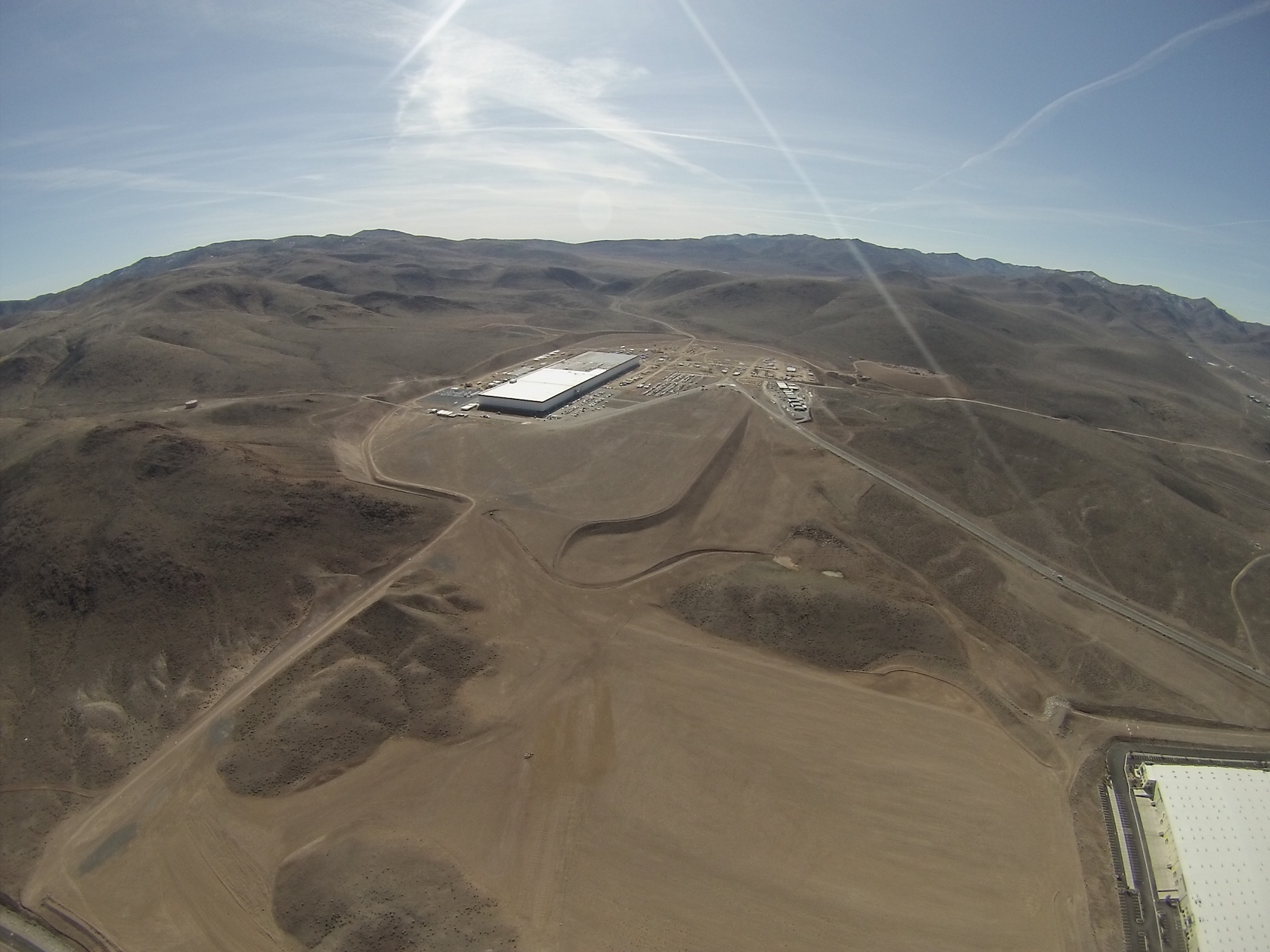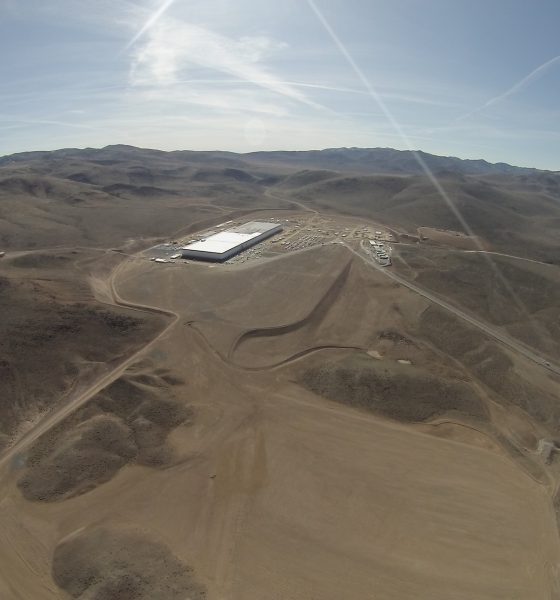

Energy
Mysterious cryptocurrency co. buys out land around Tesla’s Gigafactory
Tesla’s Gigafactory in Nevada will soon be joined by Blockchains, LLC in the Tahoe-Reno Industrial Center, with the cryptocurrency firm purchasing 67,125 acres of the 105,000-acre industrial area. Blockchains, LLC’s massive site would be home to its main campus, as well as the company’s other pertinent facilities.
Blockchains, LLC’s purchase of the massive plot of land in the industrial center was confirmed by partner-broker Lance Gilman, who noted that he closed escrow last week on the sale of the land to the cryptocurrency firm. For perspective, Tesla, one of the anchor tenants at the park with its Gigafactory owns nearly 3,000 acres at the center. Google purchased 1,210 acres at the park in 2017. Combined, the two technology giants own a little more than 4,000 acres or roughly 6% of the 67,000 acres being purchased by Blockchains, LLC.
What’s particularly interesting, however, was the fact that the purpose of the land acquisition is shrouded in mystery, as are details for the company itself.
In a statement to The Nevada Independent, Gilman noted that the Blockchains, LLC deal was worth around $175 million. Gilman did not reveal many details about the cryptocurrency firm’s projects in the area, though the TRIC executive teased that the company’s corporate headquarters and software design research center would be built on the site. Overall, the TRIC partner-broker stated that he is quite optimistic about the potential of blockchain technology.
“It has been explained to me that this particular process will revolutionize the globe in a more dramatic way than the internet,” Gilman said.
While very little is currently known about Blockchains, LLC, the company’s website invokes the idea that the mysterious firm is highly dedicated to the development and research of blockchain technology, the backbone of cryptocurrencies such as Ethereum and Bitcoin. According to the company’s official website, Blockchains, LLC is involved in projects focusing on financial services, software development of distributed applications (DAPPS) for the Ethereum blockchain, and trusted identity solutions.
The company is still new, however, with the company’s name registered in Nevada back in May 2017. Listed in the cryptocurrency firm’s registration is California attorney Jeffrey Berns, who is part of the company that owns the URL blockchains.com. Despite the air of mystery around the company and its massive investment in the TRIC, however, Berns has noted in his LinkedIn profile that the firm plans to stay in “stealth mode” for the time being.
As noted in a report from Nevada Newsmakers, Blockchains, LLC’s land in the Tahoe-Reno Industrial Center would be part of the Emerald City initiative, which aims to build a city in the massive industrial area. Emerald City would include a man-made lake, a 500-acre town center, hotels, as well as thousands of housing units and apartments. Shopping centers that would be established in the area are expected to showcase Blockchains, LLC’s technology and services.
Gilman credits Tesla as a key driver in the influx of new, progressive companies that have invested in the industrial park in recent years. According to Gilman, the interest of firms such as Blockchain, LLC appears to have been triggered by Tesla’s decision to set up shop in the center.
“When we met Tesla, that put us on an entirely different international platform. And when that platform started to grow, all of a sudden, here came Switch and others and we just had these corporate groups come in here, following Tesla all of a sudden. And so we’ve entered the tech world,” Gilman said, according to a Nevada Newsmakers report.
Currently, the industrial center is dominated by structures from firms such as Tesla, Google, and Switch. Tesla, for one, has selected the area to be the site for its Nevada Gigafactory 1, which manufactures batteries for its fleet of electric vehicles and energy storage units. As we noted in a recent report, Gigafactory 1 appears to be growing from within, with the California-based electric car maker and energy firm not expanding the facility for the last six months. Once Tesla’s Nevada Gigafactory is completed, however, the facility would be the largest building in the world by footprint.

Cybertruck
Tesla updates Cybertruck owners about key Powershare feature

Tesla is updating Cybertruck owners on its timeline of a massive feature that has yet to ship: Powershare with Powerwall.
Powershare is a bidirectional charging feature exclusive to Cybertruck, which allows the vehicle’s battery to act as a portable power source for homes, appliances, tools, other EVs, and more. It was announced in late 2023 as part of Tesla’s push into vehicle-to-everything energy sharing, and acting as a giant portable charger is the main advantage, as it can provide backup power during outages.
Cybertruck’s Powershare system supports both vehicle-to-load (V2L) and vehicle-to-home (V2H), making it flexible and well-rounded for a variety of applications.
However, even though the feature was promised with Cybertruck, it has yet to be shipped to vehicles. Tesla communicated with owners through email recently regarding Powershare with Powerwall, which essentially has the pickup act as an extended battery.
Powerwall discharge would be prioritized before tapping into the truck’s larger pack.
However, Tesla is still working on getting the feature out to owners, an email said:
“We’re writing to let you know that the Powershare with Powerwall feature is still in development and is now scheduled for release in mid-2026.
This new release date gives us additional time to design and test this feature, ensuring its ability to communicate and optimize energy sharing between your vehicle and many configurations and generations of Powerwall. We are also using this time to develop additional Powershare features that will help us continue to accelerate the world’s transition to sustainable energy.”
Owners have expressed some real disappointment in Tesla’s continuous delays in releasing the feature, as it was expected to be released by late 2024, but now has been pushed back several times to mid-2026, according to the email.
Foundation Series Cybertruck buyers paid extra, expecting the feature to be rolled out with their vehicle upon pickup.
Cybertruck’s Lead Engineer, Wes Morrill, even commented on the holdup:
As a Cybertruck owner who also has Powerwall, I empathize with the disappointed comments.
To their credit, the team has delivered powershare functionality to Cybertruck customers who otherwise have no backup with development of the powershare gateway. As well as those with solar…
— Wes (@wmorrill3) December 12, 2025
He said that “it turned out to be much harder than anticipated to make powershare work seamlessly with existing Powerwalls through existing wall connectors. Two grid-forming devices need to negotiate who will form and who will follow, depending on the state of charge of each, and they need to do this without a network and through multiple generations of hardware, and test and validate this process through rigorous certifications to ensure grid safety.”
It’s nice to see the transparency, but it is justified for some Cybertruck owners to feel like they’ve been bait-and-switched.
Energy
Tesla starts hiring efforts for Texas Megafactory
Tesla’s Brookshire site is expected to produce 10,000 Megapacks annually, equal to 40 gigawatt hours of energy storage.

Tesla has officially begun hiring for its new $200 million Megafactory in Brookshire, Texas, a manufacturing hub expected to employ 1,500 people by 2028. The facility, which will build Tesla’s grid-scale Megapack batteries, is part of the company’s growing energy storage footprint.
Tesla’s hiring efforts for the Texas Megafactory are hinted at by the job openings currently active on the company’s Careers website.
Tesla’s Texas Megafactory
Tesla’s Brookshire site is expected to produce 10,000 Megapacks annually, equal to 40 gigawatt hours of energy storage, similar to the Lathrop Megafactory in California. Tesla’s Careers website currently lists over 30 job openings for the site, from engineers, welders, and project managers. Each of the openings is listed for Brookshire, Texas.
The company has leased two buildings in Empire West Business Park, with over $194 million in combined property and equipment investment. Tesla’s agreement with Waller County includes a 60% property tax abatement, contingent on meeting employment benchmarks: 375 jobs by 2026, 750 by 2027, and 1,500 by 2028, as noted in a report from the Houston Business Journal. Tesla is required to employ at least 1,500 workers in the facility through the rest of the 10-year abatement period.
Tesla’s clean energy boom
City officials have stated that Tesla’s arrival marks a turning point for the Texas city, as it highlights a shift from logistics to advanced clean energy manufacturing. Ramiro Bautista from Brookshire’s economic development office, highlighted this in a comment to the Journal.
“(Tesla) has great-paying jobs. Not just that, but the advanced manufacturing (and) clean energy is coming to the area,” he said. “So it’s not just your normal logistics manufacturing. This is advanced manufacturing coming to this area, and this brings a different type of job and investment into the local economy.”
Energy
Tesla and Samsung SDI in talks over new US battery storage deal: report
The update was related by industry sources and initially reported by South Korean news outlets.

Recent reports have suggested that Tesla and Samsung SDI are in talks over a potential partnership to supply batteries for large-scale energy storage systems (ESS).
The update was related by industry sources and initially reported by South Korean news outlets.
ESS batteries to be built at Samsung’s Indiana plant
As noted in a report from Korea JoongAng Daily, the demand for energy storage systems has been growing rapidly in North America, thanks in no small part to the surge in AI investments across numerous companies. With this in mind, Tesla has reportedly approached Samsung SDI about a potential battery supply deal.
The deal is reportedly worth over 3 trillion Korean won (approximately $2.11 billion) and will span three years, according to The Korea Global Economic Daily. A battery supply deal with Samsung SDI could make sense for Tesla as the company already has a grid-scale battery, the Megapack, which is perfect for industrial use. Samsung SDI could simply supply cells for the EV maker.
Production of the batteries would reportedly take place at Samsung SDI’s joint venture factory with Stellantis in Indiana, which is currently under construction. Samsung SDI recently announced plans to use part of that plant’s EV lines to produce cells for ESS, with a targeted capacity of 30 GWh by the end of next year.
Tesla and Samsung’s partnership
At present, only a handful of manufacturers, including Korea’s LG Energy Solution, Samsung SDI, SK On, and Japan’s Panasonic, are capable of producing energy storage-scale batteries domestically in the United States. A Samsung SDI official issued a comment about the matter, stating, “Nothing has been finalized regarding cooperation with Tesla.”
The possible energy storage system deal adds another layer to Tesla’s growing collaboration with Samsung, which is already in line as a partner in the upcoming production of Tesla’s AI5 and AI6 chips. Early sample manufacturing of the AI6 is expected to begin in South Korea, with mass production slated for Samsung’s Texas-based Taylor foundry when it starts operations.
The AI6 chip will power Tesla’s next wave of high-volume projects, including the Optimus humanoid robot and the autonomous Cybercab service. Musk has called the partnership with Samsung a “real collaboration,” adding that he personally plans to “walk the line” at the Taylor facility to speed up progress.








